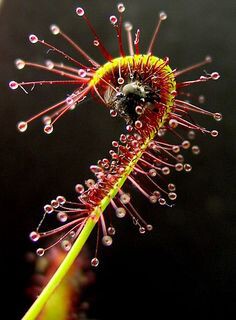 More than 700 species of flowering plants are considered endangered by the United States Fish and Wildlife Service. Certain species of plants run the risk of becoming extinct due to residential expansion, loss of habitat and pollution.
More than 700 species of flowering plants are considered endangered by the United States Fish and Wildlife Service. Certain species of plants run the risk of becoming extinct due to residential expansion, loss of habitat and pollution.
This small minority of extraordinary plants are considered the rarest in the world. They also hold unique features and characteristics, such as the Corpse flower that smells like rotting meat or the Nepenthes tenax which feeds on small rats and birds. The following flowers are truly few and far between, each having their own unique background.
1. Cape Sundew
Drosera capensis, commonly referred to as Cape sundew, is a carnivorous plant native to South Africa. The rosette-forming plant easily grows in nature due to the vast amount of seeds it produces. Cape sundew produces leaves that are covered in tentacles. These brightly covered tentacles secrete sticky mucilage used to trap arthropods. When insects become trapped, the leaves roll towards the center of the plant. Cape sundew can be propagated via seed, root cuttings or leaf cuttings. It grows well in open sunny areas and is among one of the easiest carnivorous plants to grow indoors.
2. Corpse Flower
Amorphophallus titanium, also known as titan arum or corpse flower, is a type of flowering plant endemic to western Sumatra. The corpse flower has the largest unbranched inflorescence in the world, reaching over 10-feet in height. It consists of a spadix of flowers wrapped in a green spathe which resembles a large petal. The scent of the corpse flower is similar to that of rotting meat, attracting Flesh Flies and carrion-eating beetles. During bloom, the spadix’s tip is human body temperature which assists in the evaporation of the perfume.
3. Ghost Orchid
Dendrophylax lindenil, also known as Ghost orchid, Palm polly and White frog orchid, is a perennial epiphyte. An endangered orchid in nature, cultivation of the plant has proven difficult. It consists of flat green roots with distinctive track marks used for moisture absorption. The velamen, or outer layer, is used to obtain water and nutrients as well as for protection of the inner layers. The Ghost orchid blossoms between June and August and grows to 2 to 3-inches in length and 1 to 2-inches in width.
4. Schweinitz’s Sunflower
Helianthus schweinitzii, known by its common name Schweinitz’s sunflower, is endemic to North and South Carolina. It’s one of the rarest plants in the United States with approximately 90 known populations. Schweinitz’s sunflower flowers for two to three weeks during early October. The plant is thought to have occupied prairie-like habitats or savannas. Schweinitz’s sunflower can thrive in a variety of soil types but is generally found growing in poor, shallow, rock or clay-like soils.
5. Seven-Son Flower
Heptacodium miconioides, referred to as Seven-son flowers, were founded in 1980 in China. This shrubby plant belongs to the honeysuckle family that grows as a multi-stemmed shrub. Seven-son flower leaves can reach between 15 and 20-feet tall with a spread almost as wide. As the plant grows larger, the bark begins to peel, revealing a gray to brownish display. Seven-son flowers are winter hardy plants that have open blooms that persist for several weeks.
6. Showy Lady’s Slipper
Cypripedium reginae, or Showy lady’s slipper, is a rare temperate orchid native to North America. While the plant produces large amounts of seeds for every seed pod, it typically reproduces by vegetative reproduction. Showy lady’s slipper has vanished from many areas of the world due to habitat loss, making it a relatively rare plant. It typically grows in wet lands and open wooded swamps. It can be found in Atlantic Canada to the eastern United States.
7. Middlemist’s Red
Camellia japonica, or Middlemist’s red, is one of the rarest flowers in the world with only two known plants in existence. The flower received its name from a gardener, John Middlemist, who brought it back with him in 1804 from China. The Middlemist’s red camellia has been flowering for nearly two centuries several miles outside of China. The only two plants reside in the conservatory at Chiswick, London and Waitangi, New Zealand.
8. Nepenthes Tenax
Tenacious, or Nepenthes tenax, is a lowland species of plant native to northern Queensland, Australia. The tropical flower grows to a height of 40-inches and has a self-supporting stem. Nepenthes tenax is known as a flesh-eating pitcher plant. Botanical archaeologists believe that the plant is able to consume mice, small rats, lizards and even small birds.
9. The Black Bat Flower
Tacca chantrieri, commonly known as the Black bat flower, is an unusual species that grows wild in the tropical forests of Yunnan Province, China. Black bat flowers can grow as tall as 36-inches. The black bat-shaped flowers of the plant can become as wide as 12-inches. Each flower has long whiskers that grow to a maximum of 28-inches. Black bat flowers require proper air circulation and shade. The soil should be acidic and the area frost-free.
10. Rafflesia: Parasitic Flower
Rafflesia is a genus of nearly 28 species of parasitic flowering plants found in southeastern Asia. The plant has no leaves, stems or true roots. The only visible part of the plant is a five-petaled flower supported by a host vine. In some species of Rafflesia, the flower can grow up to 39-inches in diameter and weigh up to 22-pounds. The plant has an odor similar to that of rotting flesh and is commonly referred to as the “meat flower.” The scent attracts insects which transport pollen from the male to the female flowers.